The sights and sounds of hundreds of Sandhill Cranes creates one of the great American birding experiences. Therefore, when we photograph cranes where they concentrate in big numbers during winter, spring, and fall the experiences should be most rewarding, and that was surely the case last Friday morning when I hit the crane jackpot. During my migration south, I planned an overnight at Decatur, Alabama, just outside Wheeler National Wildlife Refuge where about 20,000 Sandhill Cranes spend the winter annually.
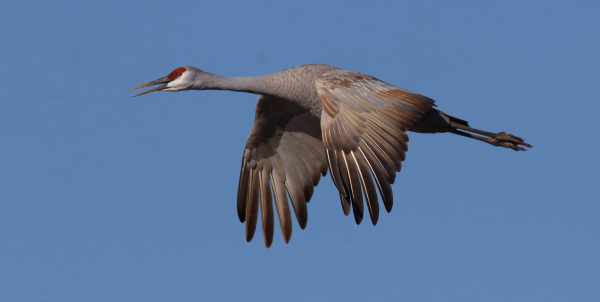
Another level of excitement was added by the presence of 15 wintering Whooping Cranes, part of the reintroduced Eastern Migratory Population that nests in Wisconsin. But Wheeler Refuge covers an expansive area that provides the great white cranes plenty of landscape to remain unseen. And traditionally, Whooping Crane sightings are limited to white dots in the distance, but their presence and the potential of seeing one or more of the rare cranes provided an underlying level of excitement to the morning.
Only a few miles beyond the town, as soon as the highway reached water, Sandhill Cranes began appearing along the wetland edges and I quickly found a feeding flock of about a hundred cranes in a convenient pull-off location where I could park my mobile blind close enough to use my 150-to-600mm zoom lens without altering the cranes’ behavior. I mostly concentrated on photographing Sandhills at the end of their flight from their roosting area on the edge of shallow water to the harvested corn field where they were feeding.
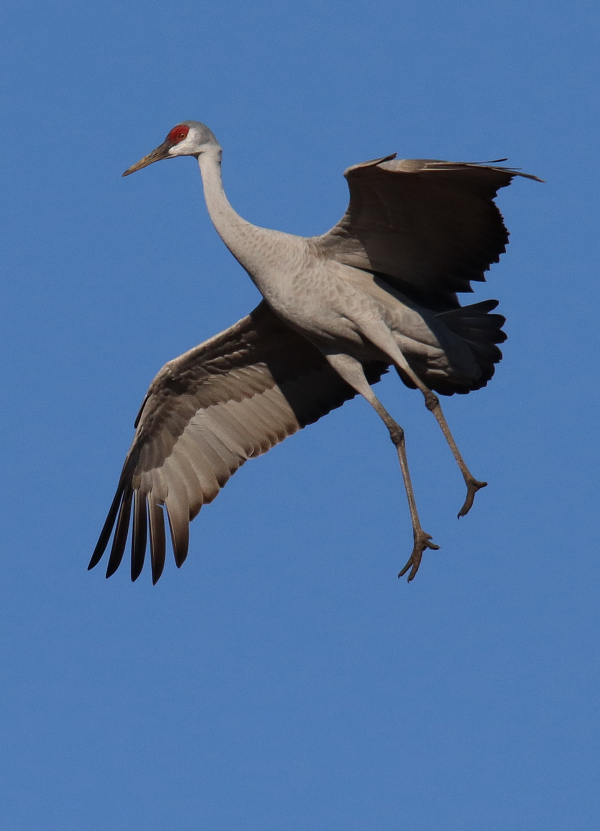
Seeming to float downward as if parachuting, the fast shutter speed stopped this Sandhill’s coasting motion for a sharp image taken from the ‘mobile blind’ (600mm zoom lens, f-10 aperture, 1/1250 shutter speed, ISO 400).
|
Actually, I could only get a clear photo path as the birds crossed the tree tops to my right, providing a clear view of the cranes against a blue morning sky with perfect sunlight beaming at a low-angle from behind me. During these winter months, the direction of the sunlight is angled nicely for most of the daylight hours, with mid-morning and mid-afternoon the best natural light in my book, as long as the sun is at your back, and the birds are in front of you.
There was a continuous flight of small flocks of Sandhills that tended to break up into smaller groups of 2 or 3 as they prepared to land. Some flocks would circle, providing different angles to photograph them. Many groups would “parachute” downward after clearing the tall trees, cupping their wings and extending their legs downward to switch from a horizontal flight position into a vertical one with their head held high. The cranes also create greater stability by hanging their legs downward, and gravity seems to have more of an effect on them too as waft downward in paragliding fashion. I always enjoy watching these interesting parachuting descents, and photographing cranes immersed in this activity was especially fun.
I also concentrated on trying to photograph the birds as they landed, which required a few wingbeats as they dropped into place among the assemblage of cranes. To be honest, the scenery surrounding the feeding cranes wasn’t very pleasing to the eye, and I found that when the cranes dropped into the area with bare trees in the background and corn stalks on the ground, the autofocus wasn’t as accurate as I would have expected. Anyway, my best photos were of birds in flight against the clear blue sky, as expected.
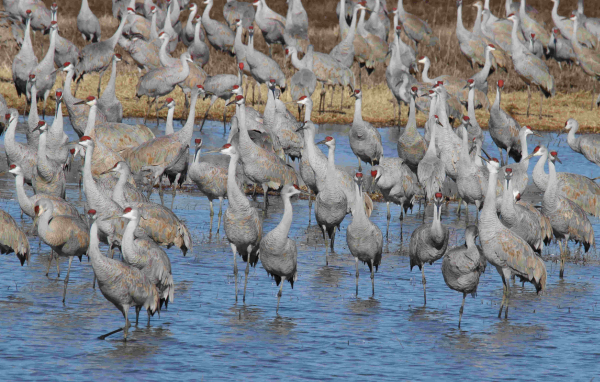
The Sandhills provided quite an elevated level of excitement as their calls filled the chilly morning air and their movements in and out of the flock fueled my camera action. After about 40 minutes, I thought I’d try another location, and perhaps I could find a few white cranes in a flock. As I returned to the highway, I saw the sign pointing to the refuge headquarters with a couple vehicles pulling in, so I followed their lead. There were more flocks of Sandhills feeding in fields along the mile-long road that led to the headquarters, and I was especially drawn to a close flock that was assembled in the shallows along the shore of a blue water marsh. I took a few photos, then continued to the new observation building that beamed architectural excellence with expansive one-way viewing windows to see Sandhill Cranes within 15 feet, as well as nearby Gadwalls, Lesser Scaup, Green-winged Teal, and Mallards with a flock of resting White-fronted Geese and more cranes in the distance.
Photo Blind Options
Next stop was the new refuge photo blind, a simple empty shell of a building positioned on the edge of a shallow marsh with almost no vegetation along the shore; a perfect roosting area for cranes and a super photo location. People’s approach to the blind was shielded by the surrounding woodland and the blind itself, and once you were inside, the birds could not see you or your movements, except when you opened one of the many small portholes to position your camera for close photo opportunities of Sandhills in perfect morning light. The cranes were abundant and close, wading and resting in water that reflected the clear blue sky; calling, interacting occasionally, and providing exceptional photo ops. Cranes eventually flew low over the assembled flocks, providing a variety of flight angles in a blue sky setting that was hard to beat.
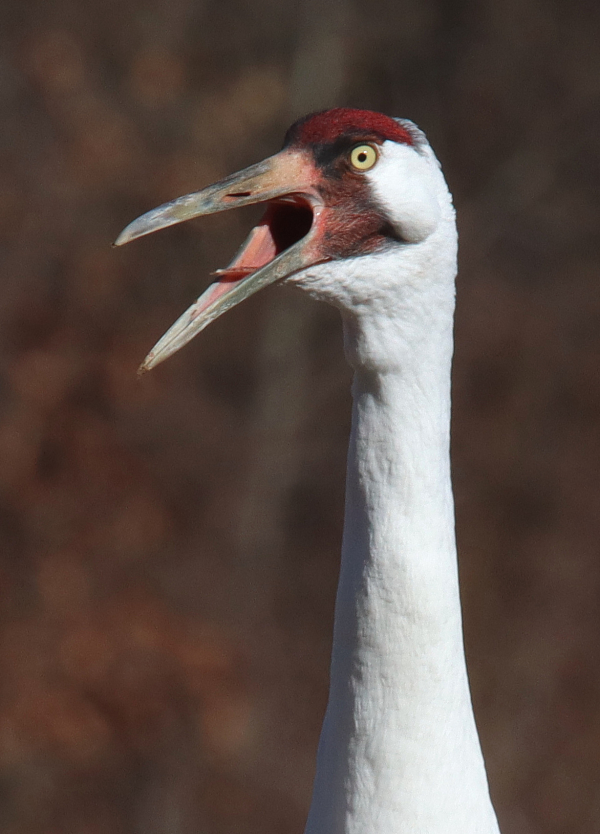
Paul never imagined he would be so close to a Whooping Crane, able to get such a close focus of the face of Whooper trumpeting. His primary tip for taking such an image is simple: Focus on the eye (photo info: 600mm zoom lens, f-14 aperture, 1/640 shutter speed, ISO 400).
|
To be honest, I’ve never had much luck using refuge photo blinds, but this new addition at Wheeler Refuge provided exceptionally close observations and photos – what fun! In this new photo blind the portholes were thoughtfully positioned at varied heights and locations from one end of the building to the other, along the extended front wall and shorter side walls, with each area of the blind providing different views and photo angles. Of course, the time of the year, the time of the day, the behavior of the birds, and other factors enter into the photo equation at a given photo blind, but during my short photo session of about 20 minutes I couldn’t have asked for better conditions or crane activity.
I would have stayed longer, but it was really time to continue my migration south. Even so, I wanted to check on any Whooping Crane sightings in the area. As I doubled back to my car, I happened to see one of the refuge staff, who shared that a Whooper was being seen among the flock of Sandhills at the other photo blind – the one next to the lot where I parked my car – ha. This new photo blind was more of an 8 foot tall wooden wall with portholes to photograph from, and as I approached the blind, I noticed a big white crane among the many Sandhills just beyond the blind’s wall. I hustled into a porthole position and was floored by the sight of an adult Whooping Crane just 60 feet away, in the open on the edge of a large flock of Sandhill Cranes – WoW!
The white crane was bent over with its head low, feeding, surrounded by gray cranes, and when the Whooper raised to its full 5-foot height, it stood out all the more, surprising me a bit by its girth. It was a robust bird, much bigger that the 4-foot tall Sandhills, and it had a commanding presence among the other cranes, displacing some as it stepped forward to forage – what an impressive bird! Its Whooper facial characteristics were clear and bright, and its plumage immaculate white. Its colored tarsal leg bands were immediately evident, marked red and white on the right leg and white and green on the left.
While photographing the impressive Whooping Crane, a social fight began among Sandhills positioned beside the big Whooper, with a couple birds spreading their wings and jumping while lunging their beaks at one another. This set off alarm calls from the surrounding Sandhills, and even the Whooping Crane chimed in – or trumpeted in, realistically! It’s especially rare to hear Whooping Cranes vocalize, so this was an exceptional opportunity to document the action of this individual at close quarters. I zoomed in for intimately close head and neck images of the Whooper calling, and zoomed out to document the Sandhills calling and the spread-winged fight scene between the Sandhills. I was doubly surprised that the Whooper continued calling after the ruckus, and I continued to photograph as the great white crane began to recede behind the Sandhills.
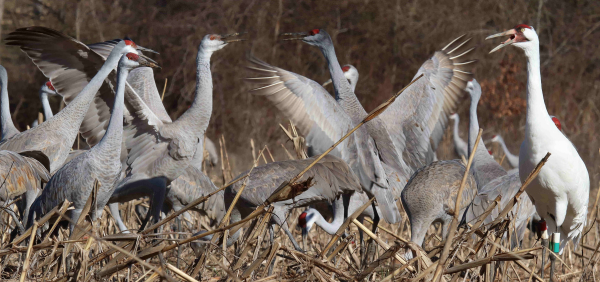
I never expected the Whooper was actually in the process of leaving as it turned its back to the blind, but in just a few minutes the Whooper was a white dot a quarter-mile away, walking along a shallow water basin among Sandhills. In retrospect, this is the usual view we get to see of a Whooping Crane, making the preceding ultra-close views extra-exceptional and hard to beat, especially hearing the loud calls at close quarters. It was an amazing and certainly unexpected opportunity, and I enjoyed talking with some other excited birders about what we all witnessed and how lucky we were to have the Whooping Crane so close – and trumpeting!
Although I started the morning by using my “mobile blind” to my great advantage, able to control where I parked, and to change my positioning when warranted. When using the refuge blinds, I didn’t have that mobile option, or a comfortable seat, but that particular morning the 2 photo blinds at Wheeler Refuge provided some exceptional opportunities to get close to both species of North American cranes, and with the weather and direction of the sun cooperating to the max, I count myself especially lucky. After all, I was not really monitoring the weather or the possibility of a sunny day during my migration. I merely positioned myself overnight in close proximity to refuges with promising birding possibilities. Tip-top photography conditions were truly hit and miss, but they couldn’t have been better.
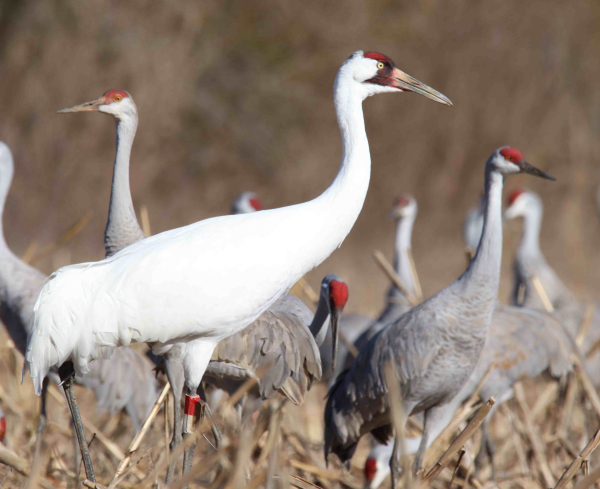
I sure hope my luck holds out during the short duration of my wintering season beyond the high levels of snow and cold I left behind. I’ll keep you posted, and hope you get a chance to work out your photo equipment during the coming week too – Good Luck!
Article and photographs by Paul Konrad
Share your bird photos and birding experiences at editorstbw2@gmail.com